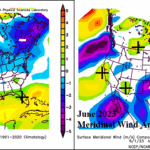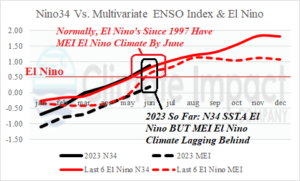
U.S. June 2023 Wind Speeds Lighter Than Normal Especially Wind Power Generating Areas
07/05/2023, 8:24 am EDTPJM-East to Roar Hot to Finish Meteorological Summer
07/09/2023, 2:05 pm EDT
Fig. 1: El Nino as conventionally defined by the Nino34 SSTA compared with multivariate ENSO index which identifies the ENSO climate.
El Nino climate delayed: The multivariate ENSO index (MEI) for MAY/JUN was +0.2 which indicates the global climate as related to ENSO phase is neutral. However, the conventional measure of ENSO phase, the Nino34 SSTA region, reached the El Nino threshold (+0.5C) in May and strengthened (+0.9C) in June. A leading contributor to the MEI calculation is the southern oscillation index (SOI) which is sharply positive the past 2 weeks and a robust La Nina-like +1.7 today. Although oceanic El Nino has formed, the expected attendant El Nino climate pattern is lagging. A resurgent -SOI pattern is necessary to push MEI past the El Nino threshold. Normally, -SOI develops during an eastward surge of the convection phase of the Madden Julian oscillation (MJO). All forecast models indicate that the current neutral MJO regime is not expected to strengthen and shift across the tropical Pacific over the next 2-3 weeks. Consequently, despite presence of oceanic El Nino, the atmospheric El Nino (climate) is likely to wait until mid-to-late Q3/2023. Although oceanic El Nino is in-place, the delayed linking of the warming ocean with the atmosphere will (also) prevent oceanic El Nino from strengthening. Dynamic models forecast a vigorous warming of the Nino34 SSTA through Q3/2023 which is likely too strong. The current Nino34/MEI combination implies El Nino is classified as “weak” and given the lack of coupling between the ocean warming and atmosphere so far, a stronger El Nino is likely delayed until Q4/2023. What causes MEI to lag a warm Nino34 SSTA? Stronger El Nino’s consolidate most of their anomalous warmth at the surface and subsurface near and east of the Dateline. Weaker El Nino’s such as the 2023 version so far have broader tropical Pacific-wide anomalous warm surface and subsurface signatures.
